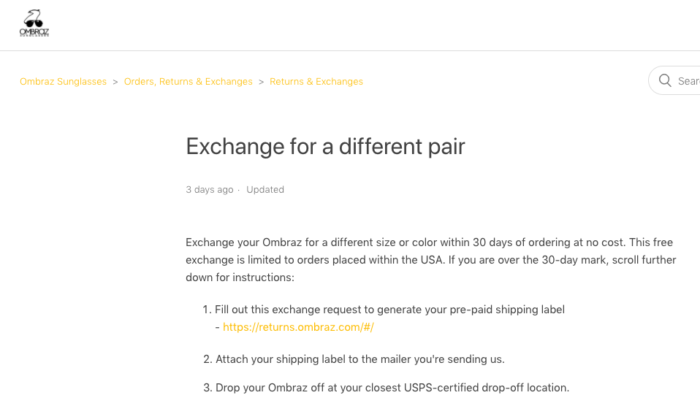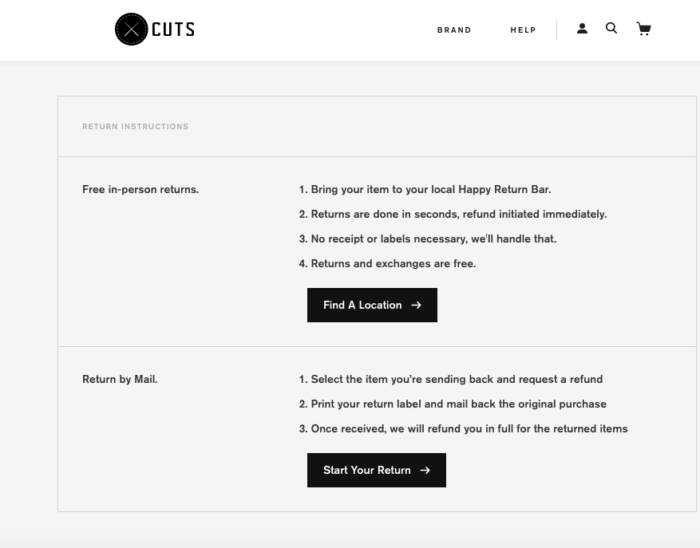Table of Contents
** Minutes
What is an ecommerce exchange policy?
Why you (and your customers) need a well-thought-out ecommerce exchange policy
Ecommerce exchange policy best practices
Exchange policy examples: how 3 ecommerce businesses manage exchanges
When it comes to retaining revenue, exchanges are one of the most powerful tools in a retailer’s arsenal. Unfortunately, the opportunity often dissipates because of long and complicated ecommerce exchange policies that push shoppers into requesting refunds instead.
A robust exchange policy helps steer the ship back on course, incentivizing shoppers to exchange an item for what they really want, while retailers get to keep the sale. Let’s take a deeper look at the importance of ecommerce exchanges policies, and review best practices for writing a successful policy of your own.
What is an ecommerce exchange policy?
Often combined with a retailer’s return policy, an ecommerce exchange policy outlines the rules and requirements for making an exchange or return. The policy is where shoppers go to gather information about the exchange window, accepted return conditions, and whether or not there’s a cost associated with an exchange.
Why you (and your customers) need a well-thought-out ecommerce exchange policy
Did you know that 67% of shoppers review a retailer’s exchange and return policy before making a purchase? The easier the policy is to digest and understand, the more likely a shopper will feel comfortable making a purchase. Below outlines the top reasons why every ecommerce business should have an exchange policy.
Exchanges are a central part of the customer experience
Exchange policies play an important role in the customer journey before the sale even takes place. An easy-to-understand policy gives shoppers the confidence to purchase from your store and will feel less worried about having a bad shopping experience.
From a post-purchase perspective, a clear exchange policy serves as a tool to encourage customers to easily swap out their purchase for something else, instead of asking for their money back. Whether the customer is debating on making a purpose or is looking to make an exchange, both cases play a huge role in shaping the overall customer experience.
A great exchange policy makes your life easier
Taking the time to create a proper exchange policy early on will save you trouble in the future. With a clear policy that leaves no room for interpretation, your customers will know exactly what to expect, reducing the need for angry customer service calls down the line.
With 87% of consumers unlikely to shop with a retailer again after dealing with a painful exchange or return process, a great exchange policy is the first step in ensuring a positive post-purchase experience. In fact, 95% of consumers shop from a brand again after a positive exchange and return experience.
A proper exchange policy can build customer loyalty
A well-written exchange policy doesn’t just prevent a bad customer experience, but also actively makes the buying experience even better. Shoppers who feel they’ll be taken care of if their purchases don’t work out are far more likely to buy more from you in the future.
The joy of effortless exchanges also influences shoppers to leave a positive online review or share their shopping experience with their family and friends. It’s a snowball effect that stems from a great exchange policy and process.
Ecommerce exchange policy best practices
To increase exchange rates, reduce refunds, and take advantage of the benefits that a great exchange policy provides, there are several best practices to keep in mind. Here are some tips for writing an exchange policy that sets you up for success.
1. Give your customers more time to make an exchange
Creating longer windows for shoppers to exchange or return may seem counterintuitive, but it’s a returns management strategy that’s proven to decrease return rates. Allowing longer than the traditional 30-day period creates less urgency for the shopper, removing returns from their top of mind and potentially causing them to forget to return altogether.
Longer exchange and return windows also benefit from the endowment effect, a behavioral theory that suggests consumers form an attachment to something the longer they own it — ultimately making them less likely to want to part with it.
2. Cover the cost of the exchange
Entice shoppers to exchange instead of return by covering the cost of exchange shipping. Not only will you save money in the end, but you’ll give shoppers an incentive to make the initial purchase. An exchange policy that shows it won’t cost them extra if they change their mind makes customers comfortable taking a chance on a product. No one wants to pay more for something they already don’t want in the first place.
3. Customise your policy to your audience
Exchange policies aren’t one-size-fits-all, so you shouldn’t just use a template to create one and then hope for the best. Instead, make sure you’re addressing the expectations and needs of your specific customer base.
For example, if you don’t have a brick-and-mortar store for in-person exchanges, consider partnering with other retail locations that host item drop-offs for direct-to-consumer (DTC) brands. Shoppers will appreciate you giving them options for whatever exchange method is most convenient, and they’ll spread the word to their friends.
4. Make sure you’re in full compliance
It’s vital to make sure you’re aware of all laws related to ecommerce exchanges and return policies. While state laws vary, most require you to disclose your policies before a customer makes a purchase.
For example, California retailers are required to post their refund policies clearly, unless they provide a cash refund, exchange, or store credit within one week of the original purchase. If they fail to do this, they are required to accept full refunds within 30 days of the sale.
5. Allow your policy to evolve
After creating your exchange policy, don’t forget that it’s not set in stone. Adjust your policy as needed to better serve your business and your customers. During COVID-19, for example, many retailers extended their exchange windows to accommodate for longer shipping times, and the temporary inability to exchange items in-store. A policy that is updated to help customers during unique or difficult times goes a long way to increase brand loyalty.
6. Follow-up with customers
Consider checking in with your shoppers after an exchange to make sure they’re happy with their new product. This shows the level of care you put into the customer experience and also allows you to stay top of mind.
7. Make sure your customer service reps know the policy
A surefire way to upset a shopper is by having a customer service representative contradict what your policy says. Shoppers will be frustrated enough that they have to call customer service in the first place, so a discrepancy between what they hear on the phone and what they read on your site will only add unnecessary fuel to the fire.
8. Clearly define what merits an exchange and what does not
To avoid conflict and confusion, your policy must be extremely clear about what customers can and cannot exchange. Ambiguous guidelines lead shoppers into thinking they have a right to exchange something that your business doesn’t allow. Using words like ‘damaged’ and ‘unworn’ should be included in your exchange policy to paint a clear picture of the condition an item must be in for it to qualify for an exchange.
Exchange policy examples: how 3 ecommerce businesses manage exchanges
Keeping best practices in mind, let’s take a look at some examples of online brands that have a great exchange policy in place.
Glyph
With a beautiful design and clean drop-down menu, Glyph’s exchange policy is an example of a retailer doing it right. Glyph keeps things clear and concise in a Q & A format that answers what the policy is and how to return an item, in one comprehensive sentence each.

Ombraz
Sunglasses-retailer Ombraz makes exchanges easy for its shoppers by listing the directions in three easy steps. The company also avoids confusion by clearly describing the condition an item must be in to be eligible for an exchange. Additionally, it provides instructions for shoppers who want to make an exchange after the policy’s 30-day exchange window has passed, helping the retailer avoid refunds by accommodating exchanges as much as possible.

Cuts Clothing
Knowing that shoppers review exchange and return policies before making purchases, Cuts Clothing designed a policy page that takes the guesswork out of exchanges. The men’s t-shirt retailer makes its returns policy concise, outlines a simple step-by-step process, and gives one clear call-to-action.

The best way to manage ecommerce exchanges
To make exchanges as easy for you as they are for your shoppers, it’s important to partner with vendors who can provide you a comprehensive solution for your exchange strategy.
ShipBob merchants can offer a robust exchange and return experience for their customers. Merchants are able to set up their returns preferences in the ShipBob dashboard, so they are processed in their preferred manner.
Additionally, ShipBob has partnerships and direct integrations with top returns platforms such as Loop Returns and Return Logic.
Conclusion
Exchanges are an opportunity to retain revenue, and it all starts with your policy. With a clear, concise policy that is customised to your audience and takes the hassle out of exchanges, you can significantly reduce refunds and keep more sales.




